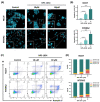NPS-1034 Induce Cell Death with Suppression of TNFR1/NF-κB Signaling in Testicular Cancer
- PMID: 35334531
- PMCID: PMC8952763
- DOI: 10.3390/medicina58030355
NPS-1034 Induce Cell Death with Suppression of TNFR1/NF-κB Signaling in Testicular Cancer
Abstract
Background and objectives: NPS-1034 with a dual inhibitory effect on Met and Axl kinase receptors has exhibited therapeutic potential in previous models. However, no study on treating testicular cancer (TC) cell lines with NPS-1034 has been established. Materials and Methods: In this study, a series of in vitro examinations of the apoptotic effect induced by NPS-1034 in TC cell lines was conducted to clarify the molecular interactions involved. Results: A decrease in cell viability rate was observed following NPS-1034 treatment, as shown in the MTT assay. Induction of the apoptotic effect was observed in TC cells as the sub-G1 and Annexin-PI populations increased in a dose-dependent manner. The involvement of the tumor receptor necrosis factor receptor 1 (TNFR1) pathway was later determined by the proteome array and western blotting. A reduction in TNFR1 and NF-κB downstream protein expressions, an upregulation of cleaved caspase-3 and -7, and a downregulation of survivin and claspin all reassured the underlying mechanism of the TNFR1 involved in the apoptotic pathway induced by NPS-1034. Conclusions: Our findings provide evidence for a potential underlying TNFR1 pathway involved in NPS-1034 treatment. This study should offer new insights into targeted therapy for TC.
Keywords: NPS-1034; TNF receptor-1; apoptosis; p50; p65; testicular cancer.
Conflict of interest statement
The authors declare that they have no competing interest.
Figures




Similar articles
-
Cordyceps militaris induces apoptosis in ovarian cancer cells through TNF-α/TNFR1-mediated inhibition of NF-κB phosphorylation.BMC Complement Med Ther. 2020 Jan 13;20(1):1. doi: 10.1186/s12906-019-2780-5. BMC Complement Med Ther. 2020. PMID: 32020859 Free PMC article.
-
Protein Kinase-Mediated Decision Between the Life and Death.Adv Exp Med Biol. 2021;1275:1-33. doi: 10.1007/978-3-030-49844-3_1. Adv Exp Med Biol. 2021. PMID: 33539010
-
Selective activation of TNFR1 and NF-κB inhibition by a novel biyouyanagin analogue promotes apoptosis in acute leukemia cells.BMC Cancer. 2016 Apr 20;16:279. doi: 10.1186/s12885-016-2310-5. BMC Cancer. 2016. PMID: 27098354 Free PMC article.
-
TRAF2 multitasking in TNF receptor-induced signaling to NF-κB, MAP kinases and cell death.Biochem Pharmacol. 2016 Sep 15;116:1-10. doi: 10.1016/j.bcp.2016.03.009. Epub 2016 Mar 16. Biochem Pharmacol. 2016. PMID: 26993379 Review.
-
TNFR1-induced activation of the classical NF-κB pathway.FEBS J. 2011 Apr;278(6):862-76. doi: 10.1111/j.1742-4658.2011.08015.x. Epub 2011 Feb 8. FEBS J. 2011. PMID: 21232017 Review.
Cited by
-
The Therapeutic Role of NPS-1034 in Pancreatic Ductal Adenocarcinoma as Monotherapy and in Combination with Chemotherapy.Int J Mol Sci. 2024 Jun 24;25(13):6919. doi: 10.3390/ijms25136919. Int J Mol Sci. 2024. PMID: 39000029 Free PMC article.
-
Anticancer potential of isoalantolactone in testicular cancer: an analysis of cytotoxicity, apoptosis, and signaling pathways.Aging (Albany NY). 2024 Oct 9;16(19):12820-12832. doi: 10.18632/aging.206076. Epub 2024 Oct 9. Aging (Albany NY). 2024. PMID: 39382942 Free PMC article.
-
NPS-1034 Exerts Therapeutic Efficacy in Renal Cell Carcinoma Through Multiple Targets of MET, AXL, and TNFRSF1A Signaling in a Metastatic Model.Cells. 2024 Oct 17;13(20):1713. doi: 10.3390/cells13201713. Cells. 2024. PMID: 39451232 Free PMC article.
References
-
- Le Cornet C., Lortet-Tieulent J., Forman D., Béranger R., Flechon A., Fervers B., Schüz J., Bray F. Testicular cancer incidence to rise by 25% by 2025 in Europe? Model-based predictions in 40 countries using population-based registry data. Eur. J. Cancer. 2014;50:831–839. doi: 10.1016/j.ejca.2013.11.035. - DOI - PubMed
MeSH terms
Substances
Grants and funding
LinkOut - more resources
Full Text Sources
Medical
Research Materials
Miscellaneous

